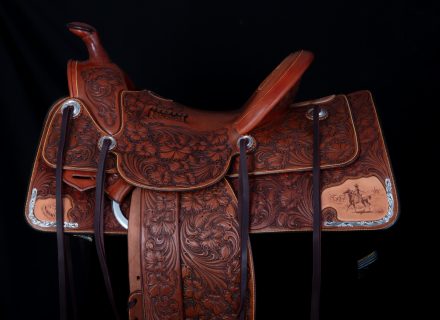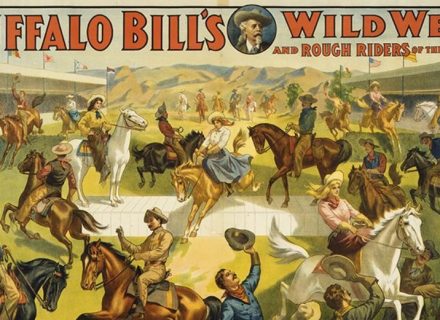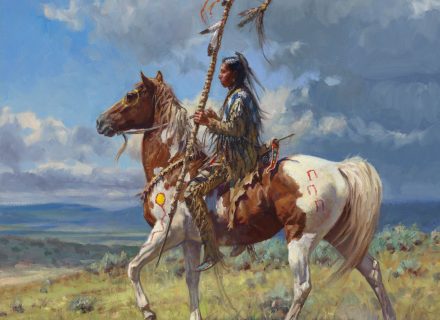The one-of-a-kind California Rose saddle is the result of a unique collaboration and unparalleled craftsmanship celebrating the 25th anniversary of the Traditional Cowboy Arts Association.
A small sign tacked to the rafters in Cary Schwarz’s saddle shop in Salmon, Idaho, said: “No Dancing,” but when four of the world’s finest saddle makers squeezed into the shop to build a saddle for the Traditional Cowboy Arts Association’s 25th anniversary—accompanied by a documentary film crew, curious students, occasional visitors, and the shop dog—nimble footwork was at a premium. From tree to finished saddle, the project was choreographed craftsmanship, the result an exquisite museum-quality collector’s piece of functional art called The California Rose.
Every member of the TCAA contributed to this historic one-of-a-kind build. The cantle-concho was designed by silversmith Scott Hardy of Longview, Alberta. The reata was built by Jay Adcock of Pawhuska, Oklahoma. A rawhide hobble was braided by Pablo Lozano and joined to a hobble ring built by Leland Hensley. Beau Compton of Tombstone, Arizona, crafted the bright-cut conchos and stirrup bolts. Texas bit and spur makers Troy Flaharty and Wilson Capron built the engraved rigging hardware and rope strap buckle. Ernie Marsh and Nate Wald combined to create a traditional quirt to finish out the build.
The California Rose is a collaborative effort by master craftsmen from complementary disciplines, but it was in the saddle shop, heated by an old wood stove and only a stone’s throw from the Salmon River, that saddle makers Pedro Pedrini, John Willemsma, Troy West, and Cary Schwarz pulled these pieces together into a contemporary expression of the traditional, and once-ubiquitous, Visalia-style California saddle.
It might also be a working homage to TCAA emeritus member and legendary Canadian saddle maker Chuck Stormes, whose original patterns of wild roses were painstakingly traced and tooled into Hermann Oak leather by John Willemsma.
“As I began to develop some confidence as a saddle maker I was attracted to what’s called a California-style saddle,” Stormes told C&I. “That means, in general, more refined—and quite often more highly decorated. Both of those things attracted me. California, in those days—the Bay Area in particular—was to saddle making what Silicon Valley is to technology today. It was the cutting edge. The best designs came from there.”
Honoring the traditions and lineage of Western craftsmanship is an integral part of TCAA members’ efforts to preserve and promote Western heritage through their own work, but they are also committed to lifting the veil of secrecy that for generations made transferring knowledge extremely difficult. That old approach made it “a very real possibility that these extraordinary skills might disappear within a generation,” says Mike Nicola, board member and chairman of the TCAA committee at the National Cowboy & Western Heritage Museum, where the 25th anniversary TCAA Exhibition and Sale will be held this September.
“We’re laying a base, a foundation, so that a hundred years from now Western craftsmanship is still celebrated,” explains Scott Hardy, who counts silversmiths Mark Drain and Al Pacetti among his influences. “Let’s not forget our mentors, and let’s not forget that they always built for the future.”
Back in Schwarz’s shop, a division of labor quickly emerged, and though each craftsman came to the project with his own techniques and experiences, there was also an intuitive choreography often found among master craftsmen at the height of their powers. While Pedro Pedrini was shaping the tapaderos and Troy West was skiving the skirts, Cary Schwarz was sewing the cantle binding with a needle and awl, and John Willemsma was tooling roses beside a window overlooking the snowy crags of the Salmon River Mountains.
Reflecting on the experience of master craftsmen gathering for the special saddle build, Schwarz is struck by the synergy of their collaboration. “There’s that cultural camaraderie where you don’t have egos clanging off one another,” he says. “We were there to learn from each other and come out of this with a work that someone else would come to appreciate. We wanted everyone’s hands on this to create a value-added, but from a cultural standpoint we are also trying to make some statements, to create narratives that are compelling.”
The TCAA craftsmen represent something of “a countercultural movement,” Schwarz says. “This saddle represents 200 years of cumulative experience, of deep narratives and time on task, of developing skills that are not easy to master. And those are things that cause the human spirit to rise.”
You have only to see the finished California Rose to experience the thrill that authentic artistry inspires.
Traditional Cowboy Arts Association Sale & Exhibition
See The California Rose saddle at the National Cowboy & Western Heritage Museum in Oklahoma City, where it went on display June 1 and will remain until it is live-auctioned the evening of September 28 during the TCAA Art Sale Weekend September 27–28. The exhibition of is on view September 27 – December 1, 2024. tcowboyarts.org, tcaa.nationalcowboymuseum.org
More on The California Rose
Author and filmmaker Craig Rullman’s short documentary The California Rose details the build of the saddle from beginning to end, with in-depth interviews of each of the participants, focusing on their specific disciplines, the mission of the TCAA, and some history of how those disciplines have evolved over time. He has also produced a 10-minute film to accompany the saddle at the National Cowboy & Western Heritage Museum, so that visitors and potential buyers can see its development and hear from the craftsmen themselves. For more information, visit thecaliforniarose.com.
PHOTOGRAPHY: Courtesy of Traditional Cowboy Arts Association Sale & Exhibition


















